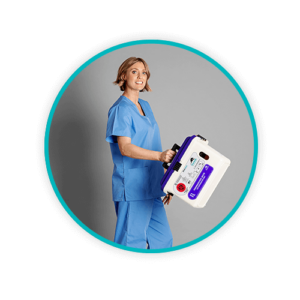10 Things to Consider with Pharmaceutical Disposal

Where do you even start when it comes to disposal of pharmaceutical waste when topics range anywhere from disposal of expired products and discontinued drugs to sharps container removal? Proper and compliant pharmaceutical waste disposal is essential. The regulations are detailed and specific and you’d better believe that if you break a rule, you can face huge fines.
Fines and penalties for improper pharmaceutical waste disposal must not be ignored. The ramifications of poor pharmaceutical waste management and disposal not only harm potential humans and animals, but the environment. When improperly disposed of, any pharmaceutical waste can make its way into water sources, soil, and the air; not to mention that insecure pharmaceutical disposal could contribute to the ongoing opioid epidemic.
You’ll damage more than your pocketbook if you’re found non-compliant. You may also irreparably damage the environment, your reputation, or a fellow human being.
You can be fined for improper pharmaceutical waste disposal, whether you’re a pharmacy, clinic, or a nursing home. The rules apply to any facility or provider dealing with pharmaceuticals.– Civil penalties for RCRA violations can range up to $70,117 per item per day via the Environmental Protection Agency (EPA). Civil penalties for Department of Transportation (DOT) HazMat violations can be up to $50,000 and for training violations a minimum of $450 per person per day can be assessed.
Daniels Health knows and understands how to properly segregate pharmaceutical waste, about labeling and containment, and most importantly, about proper pharmaceutical waste disposal regulations at federal and state levels.
Top 10 considerations when dealing with pharmaceutical waste and disposal
Are you aware of the dos and don’ts when it comes to pharmaceutical disposal? For example, are you able to differentiate between different categories of pharmaceutical waste: toxic waste (U-listed), acutely toxic hazardous waste (P-listed) and characteristic waste (D listed), which basically imply anything that’s reactive, toxic, ignitable, or corrosive.
The Environmental Protection Agency (EPA) devotes pages to pharmaceutical waste generators regarding the topic.
There’s more to consider:
- Do you separate aerosol inhalers from other types of pharmaceutical waste? If you’re not, the EPA as well as the Department of Transportation (DOT) can – and will – fine you for noncompliance.
- Do you follow guidelines and recommendations when it comes to disposal of bulk or trace chemotherapy drugs? Do you know the difference? Daniels Health does.
- Do you engage (knowingly or unknowingly) in poor, incorrect, or inaccurate labeling of hazardous waste? Do your labels state the primary hazard of the waste and are they visible?
- Are your employees trained on segregation and handling practices for pharmaceutical wastes? RCRA training may be needed.
- Do you keep records or perform inspections on a weekly basis to ensure that containers are up to standard and that waste streams are adequately separated, labeled, and contained? The EPA can ding you for a myriad of issues in this regard. In addition to storage of hazardous waste. The EPA can cite for inappropriate waste storage practices. Weekly inspections must occur for LQGs and SQGs on Central Accumulation Areas and Satellite Accumulation Areas. Conditionally Exempt Small Quantity Generators (CESQG) also termed Very Small Quantity Generators (VSQG) are not required to do these checks.
- How are you handling your expired DEA Controlled pharmaceuticals? Do you keep inventory and verify the accuracy of the DEA Form 222 provided from the reverse distributor – which documents the processes for returning. expired product, reverse distributors, and how expired products are picked up and transported?
- Are you storing your pharmaceutical waste properly? That means tracking the volumes generated and stored based on whether you’re a small quantity generator, large quantity generator, or a conditionally exempt small quantity generator (Very small quantity generator). Do you know the difference between the three?
LQGs: generate over 1,000kg/month of hazardous waste and over 1kg/month of
acute hazardous waste (p listed).
SQGs: generate over 100kg and less than 1,000kg per month of hazardous waste andless
than 1kg/month of acute hazardous waste (p listed)
VSQGs (formerly CESQG): generate less than 100kg/month of hazardous waste and less
than 1kg/month of acute hazardous waste (p listed)
- Do you have a contingency plan in place for emergencies? Did you know that every healthcare facility should have a written emergency response plan and adequate documentation of how such emergencies are dealt with? Please be mindful that full plans are required only for LQGs; SQGs are required to only have basic planning *40 CFR 262.16(b)(9).
- Are you aware of the amount of time a large quantity generator can store hazardous pharmaceutical waste, including P list waste? (It’s 90 days).
- Do you have a manifest or bill of lading for your hazardous materials, documenting when such materials have been shipped, transported, or destroyed?
Who’s involved in regulating pharmaceutical disposal?
You might be amazed at the number of agencies involved in pharmaceutical waste disposal, including everything leading up to it, including segregation, containment, storage, and transportation. Among such agencies include:
- Environmental Protection Agency (EPA)
- Drug Enforcement Administration (DEA)
- Occupational Safety and Health Administration (OSHA)
- State Environmental Protection Agencies
- State pharmacy boards
Pharmacists are increasingly being held accountable for “cradle-to-grave” management of facility pharmaceuticals and are increasingly liable for improper disposal of regulated hazardous wastes. If you or your facility is involved in any way with pharmaceuticals, you are ultimately responsible for proper pharmaceutical waste disposal.
Responsible Pharmaceutical waste management is a partnership
Adopting a cradle-to-grave approach is mandatory for any pharmaceutical waste generator, implying that it is the generator’s responsibility to guide pharmaceutical product from its generation to its disposal. Even hiring a medical waste disposal company does not remove the responsibility from the generator. Daniels Health is familiar with the laws and state regulations when it comes to pharmaceutical waste disposal. Reduce your risks of noncompliance, fines, and penalties. Contact Daniels Health to see how we can help you maintain compliance “from cradle to grave”.
Let's Talk!
Your time is valuable, and we don’t want to play hard to get. You can either phone us directly on the details listed on our contact page, or feel free to fill out this short form and one of our team members will get back to you as quickly as possible.
